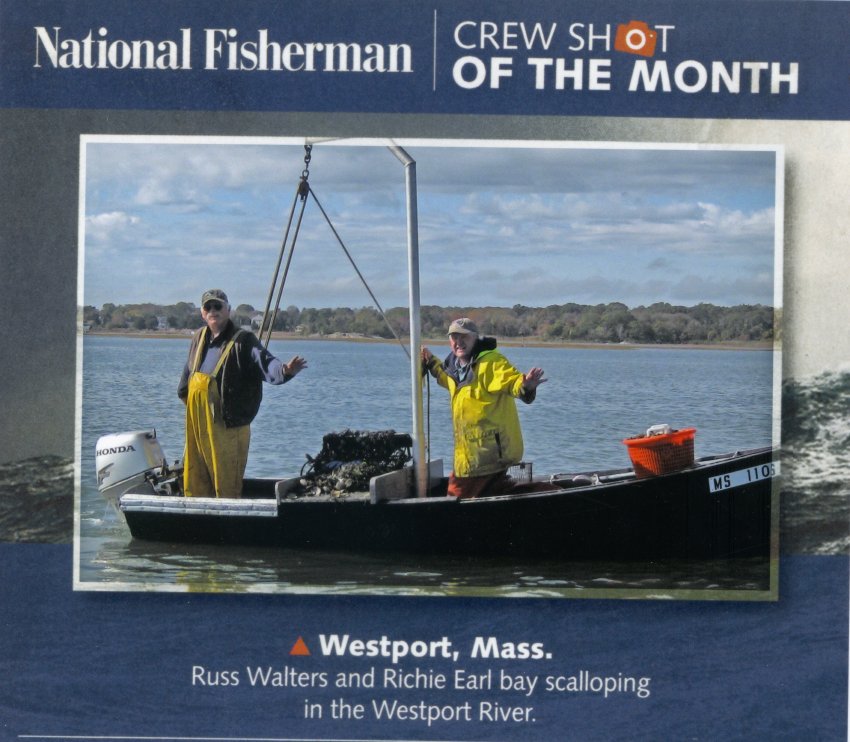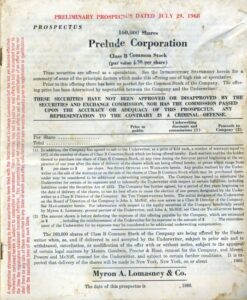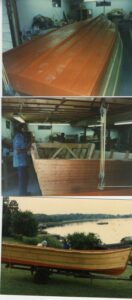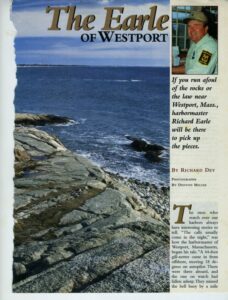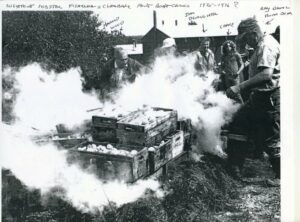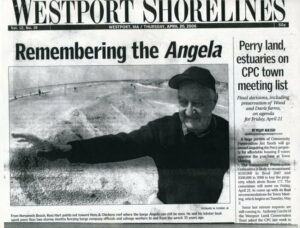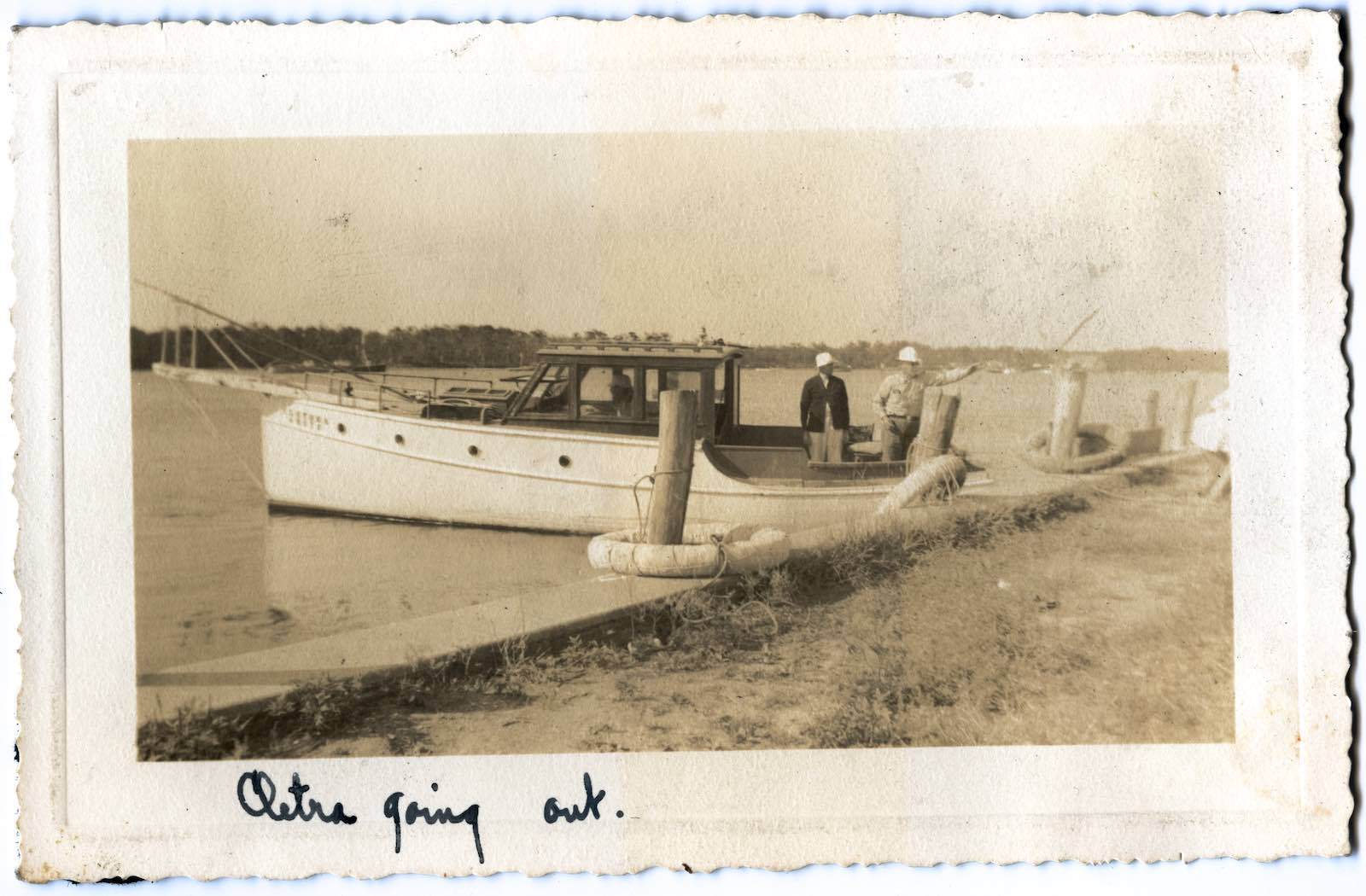The Russell Walters Collection: Lobstering, scalloping, and more
Posted on March 20, 2024 by Jenny ONeill
This collection includes photos of Hurricane Bob, 1954 hurricane, information on The Prelude Lobster Company, boatbuilding, The Angela, scalloping, lobstering, and an article on Richie Earle.
2024.014
A brief history of the Westport lobster fishery, some of the families involved and the effects on the community and the fishery.
Russ Hart, 2006
Starting back in the 1920s, after World War 1, small lobster boats usually locally built were powered with small engines, one or two cylinders, generally manufactured by Lathrop or Palmer. The only fast boats were owned by the rum runners sometimes powered with WWI liberty aircraft engines.
Prior to the 1920s, small catboats with sail and fishermen working off the beach in row boats provided the area with lobsters.
Refrigeration was non-existent and transportation was a problem. Lobsters die quickly in warm weather out of water. The lobster gear was hauled by hand. In the 20s and 30s, keeping lobsters alive and transporting them was still a problem. The catches were sold locally and the lobstermen kept their catches in floating crates about the size of lobster pots. We have to consider that during this period of time weather reports were primitive before satellites and Doppler radars. The fishermen depended on their barometers ( or the glass) and their knowledge of local conditions.
Even then, they took chances. Many of them got caught in hard weather and took a beating to get home. Browns Ledge, about 10 miles off shore. seems to have been about maximum as far as day trip fishing in this era. All the navigation was done by compass and time and anyone who dared to go to Cox ledge (about 20 miles) was really pushing it until the middle 30s. Some of the fishermen lost their boats in the 38 hurricane, some boats that survived were repaired with the help of the Red Cross, etc.
Lobstering was generally not the main source of income. Even in the 40s and 50s most of the lobstermen supplemented their income by farming, carpentering, and other modes of occupation during the winter months. A few examples: In the 30s after and during the depression, Joe Whittle’s wife ran a restaurant at 96 River Road, served great lobster meals. Fred and Etta Palmer had a restaurant on Main Road called the “Pilot House” and served great lobster meals.
Joe Brouillard was a stationary engineer at the power plant, Del Perron owned a laundry in Fall River, Eddie Croake was a union bricklayer, Don Chace had a farm in Somerset, George Hart was a carpenter etc. Many of the lobstermen who lived in town worked the rivers shellfishing, eeling, etc.
Many of the lobstermen during September and October went Fall fishing and took fishing parties for about $5.00 a head. They fished for tautog and crated them up to be sold in December hoping to get 10 cents a pound. If it snowed , and the fish got snow in their gills , they would die and that was the gamble that was taken.
This brings about terminology. We in this area through the 1940s and part of the 1950s referred to lobster equipment as lobster gear, lobster pots, nozzles were the twine entrances to the pots, the buoys were of wood , generally cedar 4 x 4 x 1 2, the rope was manila or cycal and was measured by 6 thread, 9 thread, etc. With the best of care, the rope would last 2 seasons if you were lucky.
The nozzles were made of manila twine and dipped in tar to help with the lasting quality. Some lobstermen dipped the rope in copper paint thinned with kerosene to prevent marine growth and help with lasting quality.
In the late 1930s, early 1940s, gas engines became more efficient and a flat leather belt run off the front of the engine powered a capstan to aid in the hauling of the gear. Later, V-belts replaced the flat belts. Keeping the catch alive was still a problem. Many of the larger boats, 30-40 feet had wells built into the hulls. These were water tight boxes that went from the deck to the bottom of the hull and holes were drilled through the planking to allow circulation. These wells would generally hold 3 to 400 lbs. of lobsters but packing them too tight was dangerous because of the lack of circulation.
The weight of the water in the well did add to the stability of the boat.
ln the 1950s, there was an influx of light built but very efficient boats built in Nova Scotia. These were called Novie boats and the price new was about $100.00 per foot. The government limited the size of the boats imported from Canada to about 10 net ton or about 38 ft. x 12 ft. wide. This was to protect the Maine boat builders. The World War 11 surplus gray marine engines 671 diesels and the use of the loran navigation aid from the B-29s improved navigation and on the surplus market were very reasonable. Radar became available and the industry began to expand.
In my opinion, the invention of polypropolene rope which lasts for many years and the hydraulic pot hauler allowed what we now call the off-shore fishing industry to expand. With the old manila rope it would be nearly impossible to operate.
Back to technology — with the import of 32″ wooden pots at $3.25 each with nylon nozzles from Maine the terminology changed. Pots became traps, nozzles became heads, and the wooden buoys were replaced by styrofoam buoys and the rope became polypropelene line. In the last 1950s, the lobster market became more stable with the development of large salt water pumps for the buyers to use for tanks indoors. Refrigerated trucks expanded the market to New York and the west. In the 1960s, shipping of lobsters by air to Europe and the west coast became possible with the development of Styrofoam containers. The marketability of the product increased the demand and thus the price.
The location of Westport on the coastline, its proximity to Browns Ledge and Cox Ledge has attracted fishermen fron1 other areas to fish from Westport Point. Despite having a tricky breaking inlet at the Harbor mouth and a shallow channel in the river, it was an attractive place to fish from; however, the characteristics of the harbor limited the size of the vessels that could fish from Westport. Even today, the steel boats that are using Westport as a home port have to play the tides to get into the river. Examples – Henry Clem in the late 20s and early 30s came from Hyannis and brought with him the half-round trap which local fishermen adapted to.
Carl Veeder came from Cuttyhunk, fished from both places and helped supply Laura’s Restaurant as he was Laura Allen ‘ s brother.
Bill Whipple and John Osborne came from Marblehead in the 60s. Bill Whipple came to Westport with a pot (trap) roughly 4′ x 3’ x 18″. This trap was developed by Watson Curtis of Marblehead to be used for fishing on Cashes Ledge offshore from Marblehead.
Bill was successful in catching 3 – 6 lb. lobsters offshore, a crop never tapped by local fishermen with their smaller traps.
During and after the 60s, the offshore lobster business basically exploded in this area. Bud Smith had 3 steel boats and an aluminum boat built – 2 of them are still fishing. The Captain Don, a steel boat came to Westport, Bill Whipple established the Prelude Corporation and had several large steel boats making long trips. lronically, some of these boats the Broadbill for example is nearly the same length as the Kate Cory was, perhaps not as wide or as deep. This brings us pretty much to date.
These images were shared by members of the Westport community:
Westport Lobstering Families
Joseph Fields – Lost at Sea
Son Donald Fields
Son Raymond Fields
Grandson, Albert Fields (Brad)-currently fishing
Orin Crapo
Son Orin Jr. – Lost at Sea
Grandson – Sandy Pierce – Lost at Sea
James Pierce
Son – Sandy Pierce – Lost at Sea
Grandson – George Pierce – Currently fishingFred Palmer
Son – Albert (Ab) Palmer
Son – Raymond Palmer
Donald Chace
Son – Donald Chace, Jr.
Son – Willian1 (Billy) Chace
Son – John Chace
George W. Hart
Son – Roger E. Hart
Son – Russell T. Hart
Grandson – George W. (Bill) Hart
Great Grandson – Kevin Hart – currently fishing
Carlton Macomber, Jr.- (Cukey)
Son – Paul Macomber – currently fishing
Joseph Brouillard
Son- John (Jackie) Brouillard – currently fishing
Son – Milton Brouillard
Grandson – Milton Brouillard, Jr. – Lost at Sea
Alexander (Bud) Smith
Son – Dale Smith
Brother – Herbert Smith
Peter Leuvelink – Lost his life in a boat construction accident
Son – Peter Leuvelink, Jr. currently fishing
Son – Paul Leuvelink – currently fishing
Clint Lusitano – Lost at Sea
Son – Clint Lusitano , Jr. – Lost at Sea
Costa-Rosinha family
Tony (Costa) Rosinha
Son – Albert Rosinha (died after a fishing accident)
Grandson – Albert Rosinha , Jr. – currently fishing
Grandson – Alan Dean – currently fishing
Brother – Mannie Costa Roshina
Albert Sherman
Son – Gary Sherman
William (Bill) Borges – currently fishing
Son – Chapin Borges – currently fishing
Kenneth Manchester
Son – Kenneth (Skip) Manchester
Roger (Father) Reed
Son – Roger Reed, Jr.
Son – Samuel Reed
Fishermen and boats that fished from Westport from the 1920s to 2000:
Joseph Fields, West River
Joseph Whittle, West River
Henry & Fred Palmer, Lillian, The Point
Joseph Fields, The Point
Joseph Whittle, West River
Henry & Fred Palmer
Orin Crapo, Idlewhi1e
George Hart, Hilda Alice
Salem Bshara, Salem, Westport Harbor
Henry Clem, Capt. Bill, Westport & Falmouth Westport & Cuttyhunk
Carl Veeder
Ed Croake and Father Reed, Broadbi11
Joseph Brouillard, Janice B, The Point
Adelard Perron, Ave Maria , The Point
Don Chace, Betty & Marge, The Point
Gus Robillard, Good Luck , The Point
Edward (Dill) Messier, The Point
Chace Heaton, The Point
Jim Pierce, East Beach
Bill White, East Beach
John Borden, Orin C, The Point
Joe Whittle & Al Bowers, Billy Boy, The Point
(nicknamed “‘Between Drinks”) built at the top of Sherman ‘ s Hill across from Santos’s barn
Robinson, The Point
Brad Fields*Rock ‘n Roll , The Point
Donald Fields, West River
Raymond Fields, West River
Pete Manchester, Sparrow Hawk West River
Alex (Bud) Smith*, Sherry Ann Dale, The Point
Ray Davoll, The Point
Milton Brouillard You Got to Believe, The Point
Milton Brouillard, Jr. Elizabeth Ann, The point
Peter Leuvelink, White Fly, The Point
Peter Leuvelink, Jr.*, East Beach
Paul Leuvelink*, The Point
Jim Manchester, Jessie M, The Point
Raymond Elmer Manchester, Candy & Paula, The Point
Paul Macomber & David Grace*, Cee Dee, The Point
Russ Hart & Roger Hart and Dick Squire, Jeannie H, The Point
Harold Wood, Ed Bibeau & Bill Hart, Jim Dandy, The Point
Edward (Deacon) Earle, Kay T. , The Point
Jackie Brouillard*, Janice B., The Point
Bill Whipple, Horizon & Prelude, The Point
John Osborne, Drifter
Clint Lusitano fished out of the Point then New Bedford
John Reynolds, Cindy
Tom Liggins, Laurie L., The Point
Albert Rosinha, Sheila & Linda, The Point
Billy Gell* , Gale, The Point
Curtis Davoll , Bay Breeze, The Point
Bob Haines, The Point
Orin Crapo, Jr. and Sandy Pierce, Atlantic Sword, The Point
Jim Delaughter, John Paulding, The Point
Grant Moore* Sideshow & Direction, The Point, Now New Bedford
Harry Kirby & Russell Walters, Dorothy M. , The Point
Shelton Judson & John Osborne, Moby Dick, The Point
Rob Reitano, Marci Ann, The Point
Bill Borges*, Jean B, The Point
Arthur Denault, Bridget Ann & Rodman Swift, The Point
Jim Smith, Jr., Westport Harbor
Alan Dean*Kim & Jake, The Point
Kevin Hart, Bullwinkle , The Point
John Borden, Orin C, The Point
Kevin Mello and Dave Mello*, Ocean Hunter, The Point
Bob Hebden, Scotty, The Point
Gary Sherman and Al Sherman Meredith T., The Point
Jim King, Little Gull, The Point
George Pierce*
Mike O’Connor, Shamrock , The Point
Herb Smith*Mary F. and Curlew, The Point and New Bedford
John Chace and Bill Chace
Don DePriest, Christine, The Point
Fred Cambra
Dan Sullivan
Richard Ravenelle, American Born, The Point
Arthur Berard, Billy B, The Point
Bob Lees, The Point
Brad Sherman, Laughing Gull, The Point
Hugo Denault, The Point
Paul Brayton and Richie Earle, Side Show, The Point
Bill Hart, Don Chace & Bud Smith, Jackie & Jennie, The Point
And Capt. Don
Larry Yacubian, Susan Y.
Bill Pires. Mr. Bill, The Point
Half a day Frank, The Point
Frank Dutra, The Point
Mike Mccarthy, The Point
Some of these fishermen only lasted one season and others lasted 40 or 50 years. This list is from memory and may be incomplete. It may be trivia today but it may be history tomorrow.
Currently fishing:
l would be remiss not to mention the folks who worked with me as crew over the last 45 years:
My brother Roger (Pierre) Hart, Edward (Deacon) Earle, Dick Squire, Allen Pierce. Andrew McLaughlin, Clarence (Sam) Sanford, Jeff Wilkinson, Tyler Webb and from 1990 to 2000, Ed Bibeau.
All were great people to work with.
Written by Russ Hart 2006

